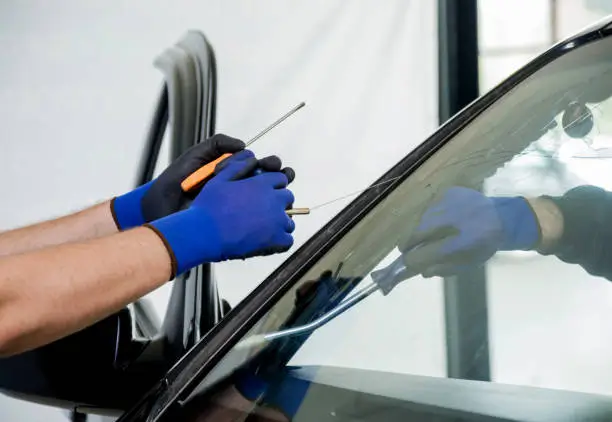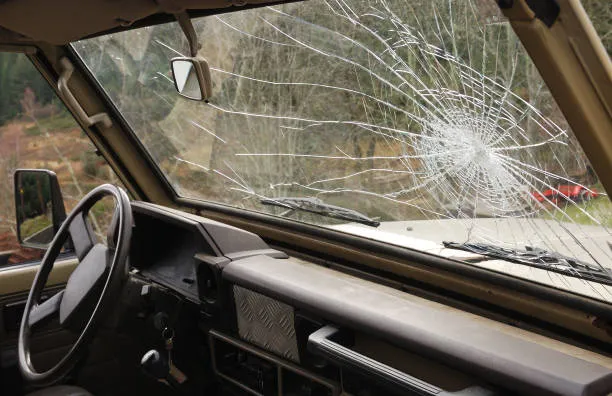Learn how to identify different types of windshield damage, understand the risks they pose, and determine when repair or replacement is necessary.
While engine checks and tire rotations are routine, many drivers fail to recognize the critical importance of a clear and intact windshield. This blog will guide you through identifying different types of windshield damage, understanding the risks they pose, and determining when repair or replacement is necessary.
Table of Contents
ToggleTypes of Windshield Damage
Windshields can sustain various types of damage, each with unique characteristics and implications. The most common forms are cracks, chips, and scratches.
- Cracks
Cracks in a windshield are lines that develop due to stress or impact. They can range from small, almost unnoticeable lines to large, spreading fissures. Cracks are especially hazardous because they can weaken the windshield’s structural integrity, increasing the risk of it shattering upon impact.
Common types include stress cracks, which typically occur without any direct impact and often result from extreme temperature changes; edge cracks, originating within two inches of the windshield’s edge, usually due to manufacturing defects or improper installation; and floater cracks, which start in the middle of the windshield and can spread rapidly, especially when subjected to further stress or impact.
Recognizing these various crack types and their effects is vital for safeguarding your vehicle’s safety and structural strength.
- Chips
Chips are small breaks in the windshield caused by debris, such as stones, hitting the glass at high speed. They can vary in severity and depth, but they’re usually less than 1” in diameter.
Different types of windshield chips pose varying risks to your vehicle’s integrity. Bullseye chips are circular damage similar to a bullseye target. Star breaks are characterized by small cracks radiating from the center, resembling a star shape, indicating significant potential for spreading and compromising the windshield’s structural integrity.
Half-moon chips resemble bullseye chips but are semi-circular in form. Combination breaks, on the other hand, combine various chip and crack patterns, posing greater challenges for repair. Understanding these chip types is essential for assessing and addressing potential risks to your windshield’s safety and longevity.
- Scratches
Scratches are surface-level abrasions caused by objects scraping against the windshield. Although scratches are typically less severe than chips or cracks, they can still obstruct the driver’s view and, if they are deep enough, compromise the integrity of the glass.
Repair or Replace?
Deciding whether to fix or replace a windshield depends on how badly it’s damaged.
When to Repair
Minor chips and cracks less than 3 inches long and not in the driver’s direct line of sight can often be repaired. Modern repair techniques now entail injecting a transparent resin directly into the affected area of the windshield. This resin hardens, restoring the glass’s structural strength. Fixing small damage promptly can prevent it from spreading and causing more significant issues.
When to Replace
Windshield replacement becomes necessary in several scenarios beyond standard cracks and chips. Severe damage, such as extensive shattering or multiple long cracks, can compromise the windshield’s structural integrity. Previous repairs that have been repeated or localized indicate potential weaknesses.
External factors like vandalism, extreme weather conditions, or collisions can also necessitate replacement. Additionally, older windshields that are worn, scratched, or pitted may impair visibility and safety.
Regulatory requirements in some areas and considerations of insurance coverage may also influence the decision to opt for replacement over repair. Ensuring a clear and structurally sound windshield is essential for maintaining safe driving conditions and compliance with road safety standards.

DIY vs. Professional Repair
While DIY windshield repair kits are available, their effectiveness varies depending on the type and extent of damage. DIY repairs are generally suitable for minor chips or cracks but may not provide the same level of durability and safety as professional repairs or replacement. Professional auto glass technicians have the expertise and equipment to assess damage accurately and perform repairs or replacements that meet safety standards.
Environmental Factors and Maintenance Tips
Environmental factors can affect windshield damage and longevity:
- Temperature Extremes: Rapid changes in temperature, such as exposure to sunlight followed by cold weather, can cause minor chips to expand into larger cracks. Parking in shaded areas or using windshield sunshades can help mitigate this risk.
- Weather Conditions: Hailstorms, falling branches, or debris kicked up by other vehicles can cause sudden and severe damage to windshields. Being aware of weather conditions and parking in protected areas during storms can reduce the risk of damage.
- Regular Maintenance: Regularly inspecting and cleaning your windshield helps identify damage early and ensures optimal visibility. Cleaning both the inside and outside of the windshield with a mild, non-ammonia-based cleaner removes dirt and debris that can obscure vision.
Understanding windshield damage is crucial for safe driving. From identifying cracks, chips, and scratches to knowing when repair or replacement is necessary, every driver must prioritize maintaining a clear and intact windshield. Engine checks and tire rotations are routine, but neglecting windshield health can compromise vehicle safety. By staying informed and proactive, drivers can ensure their windshields remain strong and safe, enhancing overall road safety for themselves and others. Remember, a clear windshield is not just a matter of visibility but also a critical aspect of vehicle structural integrity and passenger safety.
Conclusion
When it comes to your safety on the road, don’t take chances with a damaged windshield. Whether you’re dealing with minor chips, severe cracks, or even need advanced driver assistance system (ADAS) recalibration, trust the experts at Aaction Auto Glass.
As a trusted authority in windshield repair, replacement, chip repair, and ADAS recalibration, Aaction Auto Glass is dedicated to providing top-notch service to keep you and your passengers safe. Schedule an appointment today and let our experienced technicians ensure your windshield is in optimal condition. Drive safely and confidently with Aaction Auto Glass by your side.






